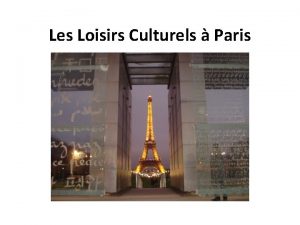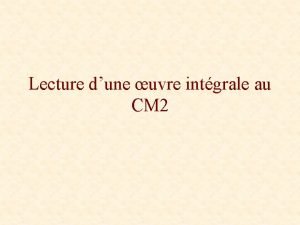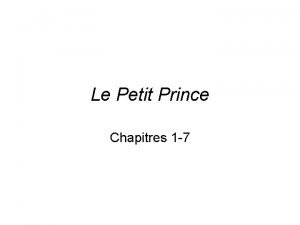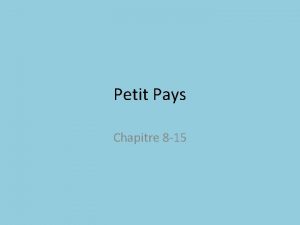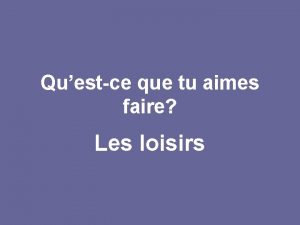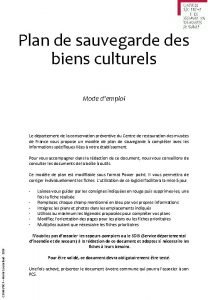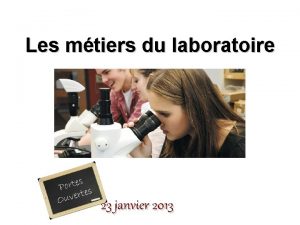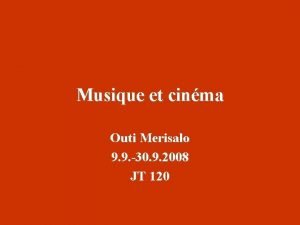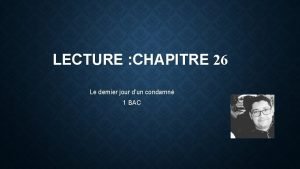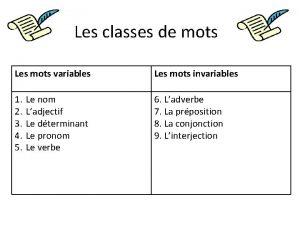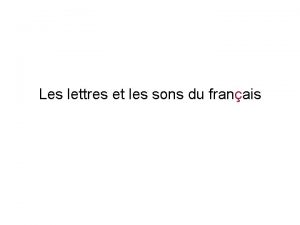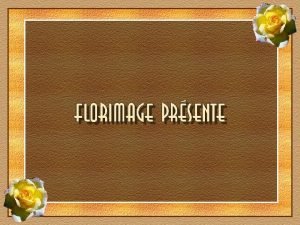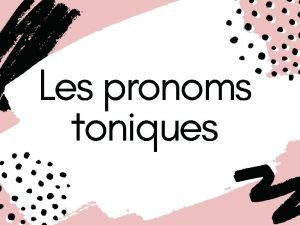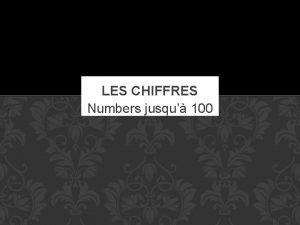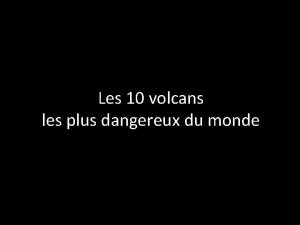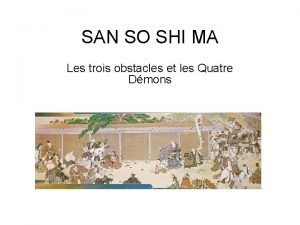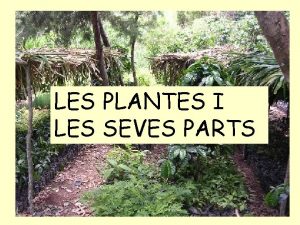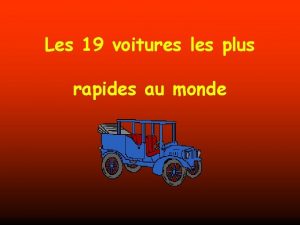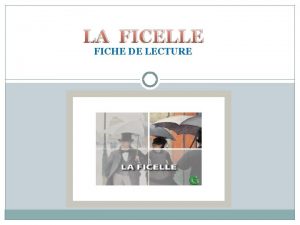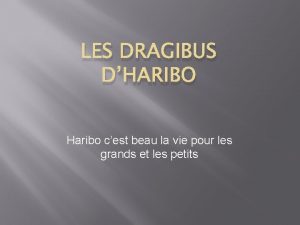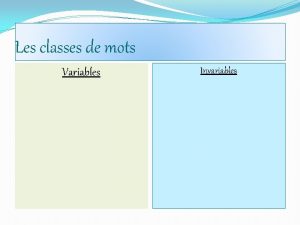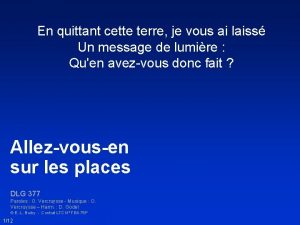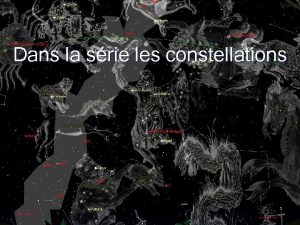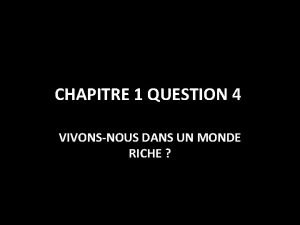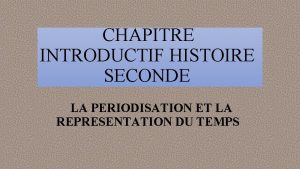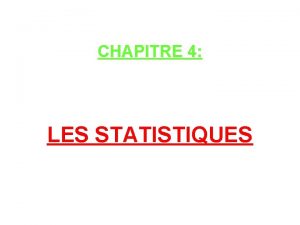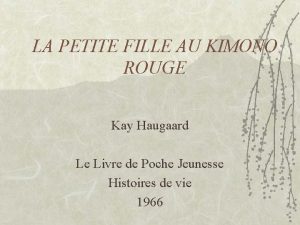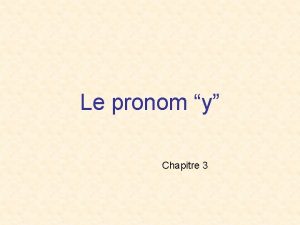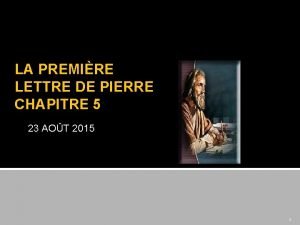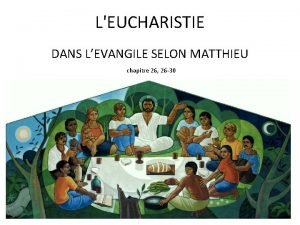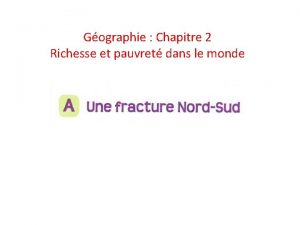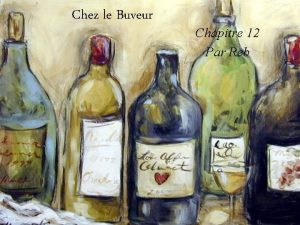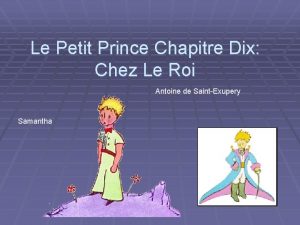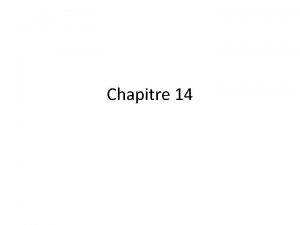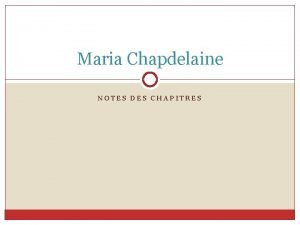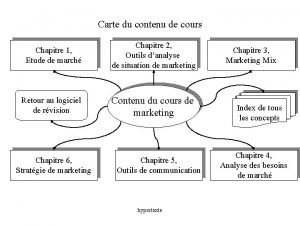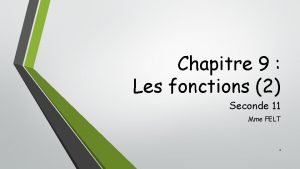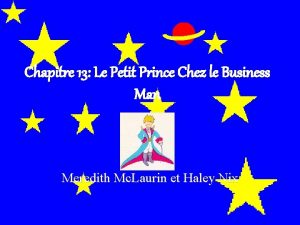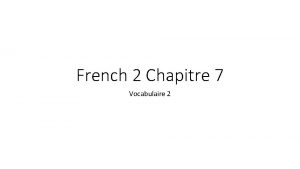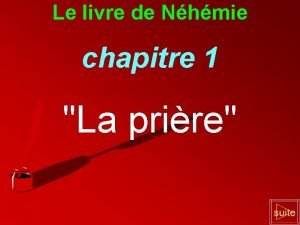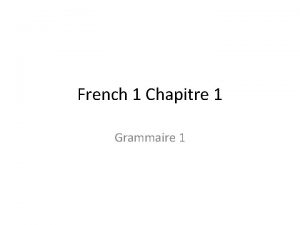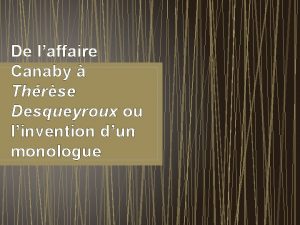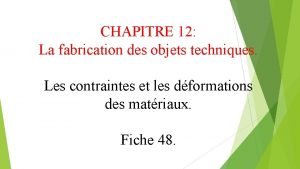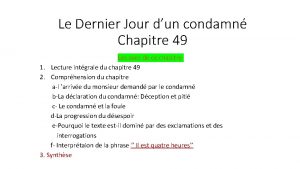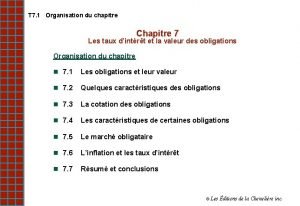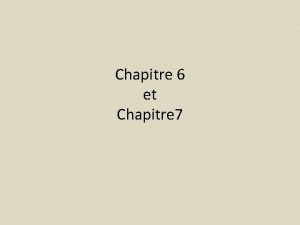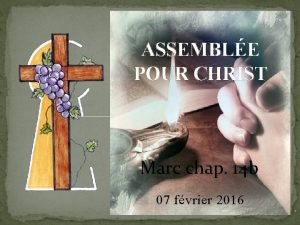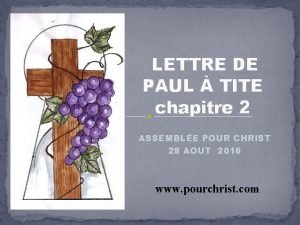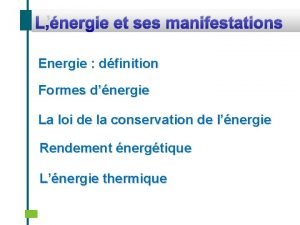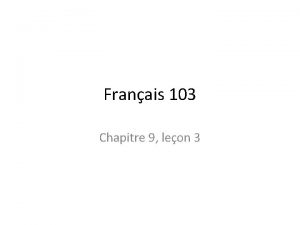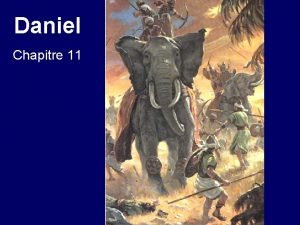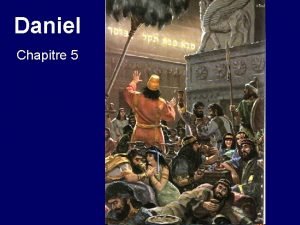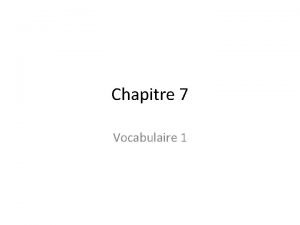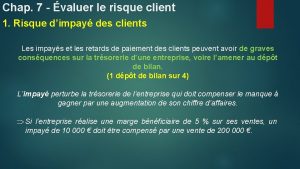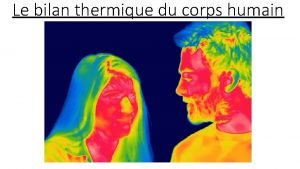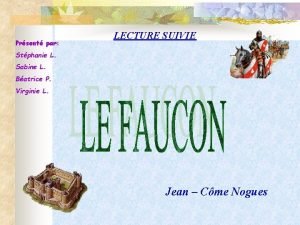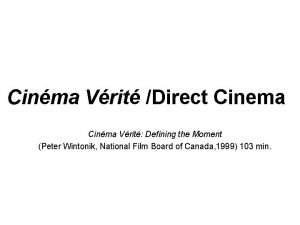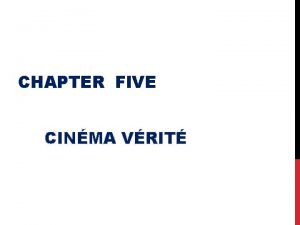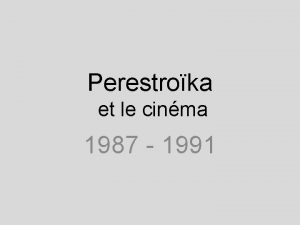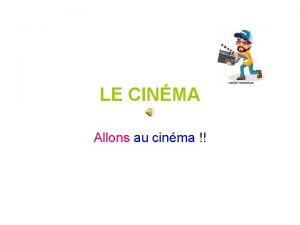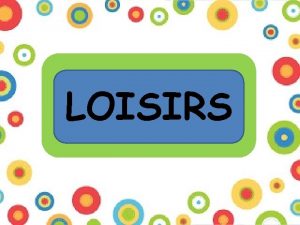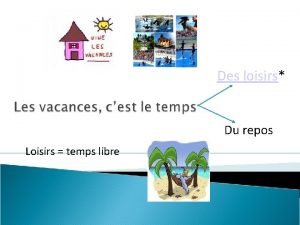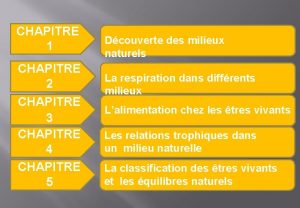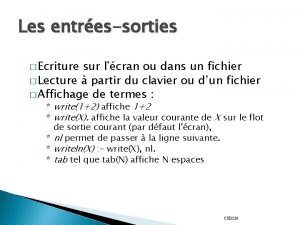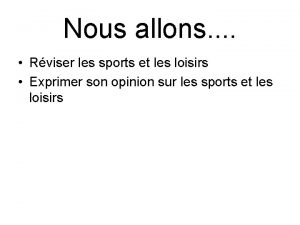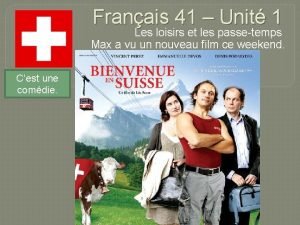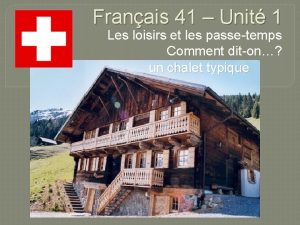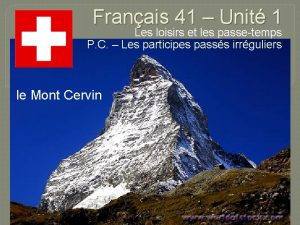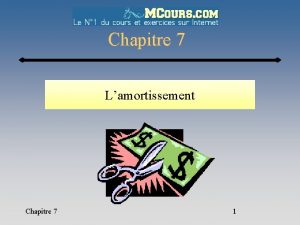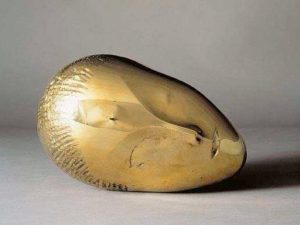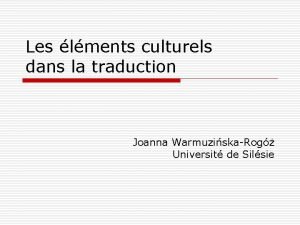Chapitre 1 Les loisirs culturels Le cinma lcran



















































































- Slides: 83

Chapitre 1 Les loisirs culturels

Le cinéma

l’écran Les places la salle de cinéma

Le guichet

Un film en DVD

Un théâtre

louer Je peux louer un film à Blockbuster.

Une actrice célèbre

Audrey Tautou est une actrice française très connue.

Un acteur connu

Une chanteuse

Un chanteur

C’est un théâtre?

C’est une professeur?

Je peux regarder des films à Blockbuster?

C’est une place?

C’est une salle à manger?

C’est un théâtre? Non, c’est un cinéma.

C’est une professeur? Non, c’est une actrice.

Tu peux regarder des films à Blockbuster? Non, je peux louer des films à Blockbuster.

C’est une place? Non, c’est un écran.

C’est une salle à manger? Non, c’est une salle de cinéma.

Une danseuse

Les danseurs

Ils dansent.

Un tableau de Pierre-Auguste Renoir

Le musée du Louvre à Paris

Le Louvre


La Pyramide du Louvre

The glass pyramid was designed by the Chinese. American architect, I. M. Pei.

The glass pyramid was designed by the Chinese. American architect, I. M. Pei.

la sculpture une statue le Penseur d’Auguste Rodin l

Un sculpteur

La peinture Un tableau La Joconde de Leonardo da Vinci

Ce garçon chanter

Ils chantent ensemble.

danser Ils dansent bien.

La porte Cette porte est ouverte. Elle n’est pas fermée.

Cette porte rouge est fermée.

C’est une sculpture?

La porte est ouverte ou fermée?

Ils dansent ou ils chantent?

Elle chante ou elle danse?

C’est une sculpture? Non, c’est un tableau.

La porte est ouverte ou fermée? La porte est ouverte.

Ils dansent ou ils chantent? Ils dansent.

Elle chante ou elle danse? Elle chante.

La vie en rose 1 h 3 h 4 h 30 La séance

Une pièce

Le dessin animé Bob l’Eponge Carrée

Le documentaire Meerkat Manor

Un film d’horreur

Un film de science-fiction

Un film d’aventures

Un film d’amour

Elle est artiste. C’est une peintre. Elle fait de la peinture. Il est artiste. C’est un peintre. Il fait un beau tableau.

savoir vs connaître

connaître –to know people/places to be familiar with je connais tu connais il connaît nous connaissons vous connaissez ils connaissent

Nous connaissons ce musée. Ils connaissent ce tableau. Tu connais ce restaurant?

savoir – to know as information je sais tu sais il sait nous savons vous savez ils savent

Nous savons que c’est le Louvre. Ils savent que c’est la Joconde. Je sais que le restaurant s’appelle Les Deux Magots.

Je connais le Président Obama.

Je sais qu’il est marié. Je sais le nom de sa femme. C’est Michelle.

Les chef-d’oeuvres du Louvre

La Victoire de Samothrace 220 to 190 BC.

The Winged Victory of Samothrace, also called Nike of Samothrace is a marble sculpture of the Greek goddess Nike (Victory), discovered in April 1863 on the Greek island of Samothrace.

One of the great surviving masterpieces of sculpture from the Hellenistic period (220 to 190 BC), Winged Victory is thought to celebrate a naval victory.

The statue shows a mastery of form and movement which has impressed critics and artists since its discovery - it is particularly admired for its naturalistic pose and rendering of the figure's draped garments, depicted as if rippling in a strong sea breeze.

The Nike swoosh represents the Wing of this famous statue. It was the inspiration for many Greek warriors.

Winged Victory has been at the Louvre since 1884.

Venus de Milo (130 -90 BC) The statue is believed to depict Aphrodite (called Venus by the Romans), the Greek goddess of love and beauty. It was discovered in 1820 inside a buried niche within the ancient city ruins of Milos on the Greek island of the same name by a peasant named Yorgos Kentrotas. It was found in two main pieces (the upper torso and the lower draped legs) along with several herms (pillars topped with heads), fragments of the upper left arm and left hand holding an apple, and an inscribed plinth

The statue is admired for its celebration of feminine beauty.

Venus de Milo (130 -90 BC)

Pablo Picasso 1881 -1973

Guernica par Pablo Picasso Guernica is a small town in the northern part of Spain. On April 26, 1937, German and Italian planes bombed the city on a market day when a maximum number of people would be out in the streets.

Picasso was outraged. He painted this large mural (11 ft x 26 ft) to protest the slaughter of innocent people.

A wide-eyed bull stands over a woman grieving over a dead child in her arms.

A horse falling in agony as it had just been run through by a spear or javelin

Townspeople in various forms of suffering

The painting was exhibited in the Spanish Pavillon of the Paris Exhibition. Picasso refused to allow the painting to go back to Spain until the Spanish had “public liberties and democratic institutions”. It was returned in 1981.


 Les loisirs culturels
Les loisirs culturels Tirez pas sur le scarabée fiche de lecture
Tirez pas sur le scarabée fiche de lecture Petit prince résumé
Petit prince résumé Le petit prince résumé simple
Le petit prince résumé simple Lecture analytique petit pays incipit
Lecture analytique petit pays incipit Qu'est ce que tu aimes faire
Qu'est ce que tu aimes faire Charnay loisirs
Charnay loisirs Sinda loisirs
Sinda loisirs Plan de sauvegarde des biens culturels
Plan de sauvegarde des biens culturels Cfc cinma
Cfc cinma Outi merisalo
Outi merisalo Cinma 4 u
Cinma 4 u Cfc cinma
Cfc cinma Examen régional le dernier jour d'un condamné chapitre 26
Examen régional le dernier jour d'un condamné chapitre 26 Ecrit expressif
Ecrit expressif Horloge stratégique
Horloge stratégique Classe de mot variable
Classe de mot variable Les lettres en français
Les lettres en français Les mots qu'on ne dit pas sont les fleurs du silence
Les mots qu'on ne dit pas sont les fleurs du silence Les parts de la flor
Les parts de la flor Preactionneurs
Preactionneurs Remplacez les mots soulignes par les pronoms convenable
Remplacez les mots soulignes par les pronoms convenable Les fonctions techniques et les solutions techniques
Les fonctions techniques et les solutions techniques Trouvez les réponses. écrivez-les en chiffres (numbers).
Trouvez les réponses. écrivez-les en chiffres (numbers). Le volcan le plus dangereux du monde
Le volcan le plus dangereux du monde Marqueur textuel
Marqueur textuel Les trois obstacles et les quatre démons
Les trois obstacles et les quatre démons Les parts de les plantes
Les parts de les plantes Les voitures les plus rapides du monde
Les voitures les plus rapides du monde Les histoires d'amour c'est comme les voyages en train
Les histoires d'amour c'est comme les voyages en train Les personnages principaux et secondaires de la ficelle
Les personnages principaux et secondaires de la ficelle Cestbeaulavie
Cestbeaulavie Un appel vient pour des soldats
Un appel vient pour des soldats Les mots variables
Les mots variables Tu aimes manger
Tu aimes manger En quittant cette terre
En quittant cette terre Les constellations les plus connues
Les constellations les plus connues Le monde du travail chapitre 2 answers
Le monde du travail chapitre 2 answers Histoire seconde periodisation
Histoire seconde periodisation Au lycée chapitre 4 vocabulaire 1
Au lycée chapitre 4 vocabulaire 1 Qualiroute chapitre g
Qualiroute chapitre g Kay haugaard
Kay haugaard The pronoun y chapitre 3
The pronoun y chapitre 3 Jean chapitre 8
Jean chapitre 8 1 pierre chapitre 5
1 pierre chapitre 5 Chapitre 2 vocabulaire 1
Chapitre 2 vocabulaire 1 Matthieu chapitre 26
Matthieu chapitre 26 Chapitre 2 richesse et pauvreté dans le monde
Chapitre 2 richesse et pauvreté dans le monde Le petit prince le buveur analyse
Le petit prince le buveur analyse Le petit prince le roi
Le petit prince le roi Chapitre 14 cinquieme rencontre
Chapitre 14 cinquieme rencontre Maria chapdelaine résumé par chapitre
Maria chapdelaine résumé par chapitre Carte chapitre 1
Carte chapitre 1 Chapitre fonction seconde
Chapitre fonction seconde Le petit prince chapitre 13
Le petit prince chapitre 13 Jean chapitre 9
Jean chapitre 9 Chapitre 7 vocabulaire 1 french 2
Chapitre 7 vocabulaire 1 french 2 La prire
La prire Jean chapitre 5
Jean chapitre 5 Daniel 12 5
Daniel 12 5 Subjects and verbs chapitre 1
Subjects and verbs chapitre 1 Henriette blanche canaby
Henriette blanche canaby Lieux de fabrication des objets techniques
Lieux de fabrication des objets techniques Chapitre 49 dernier jour d un condamné
Chapitre 49 dernier jour d un condamné Chapitre 7 observatoire
Chapitre 7 observatoire Le registre dominant dans le dernier jour d'un condamné
Le registre dominant dans le dernier jour d'un condamné Le petit prince chapitre 6
Le petit prince chapitre 6 Marc chapitre 14
Marc chapitre 14 Ainsi parle le saigneur resume de chaque chapitre
Ainsi parle le saigneur resume de chaque chapitre Tite chapitre 2
Tite chapitre 2 Jean chapitre 4
Jean chapitre 4 Chapitre 3 l'énergie et ses manifestations
Chapitre 3 l'énergie et ses manifestations Allons en ville chapitre 9 vocabulaire 1
Allons en ville chapitre 9 vocabulaire 1 Daniel chapitre 11
Daniel chapitre 11 Jean chapitre 6
Jean chapitre 6 Daniel chapitre 10
Daniel chapitre 10 Chapitre 7 vocabulaire 1
Chapitre 7 vocabulaire 1 Chapitre 7 évaluer le risque client
Chapitre 7 évaluer le risque client Exercice bilan thermique du corps humain
Exercice bilan thermique du corps humain Le faucon déniché questionnaire
Le faucon déniché questionnaire Qui est le friauche dans le dernier jour d'un condamné
Qui est le friauche dans le dernier jour d'un condamné Celui qui recoit un prophete en qualite de prophete
Celui qui recoit un prophete en qualite de prophete Matthieu chapitre 3
Matthieu chapitre 3 Jean chapitre 7
Jean chapitre 7
